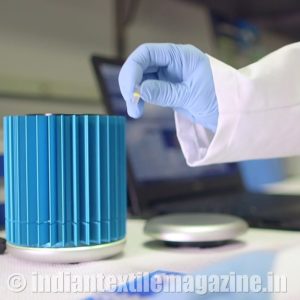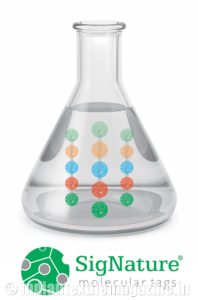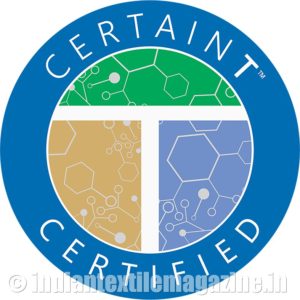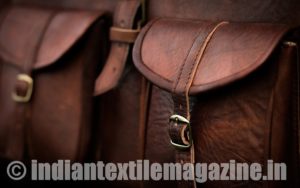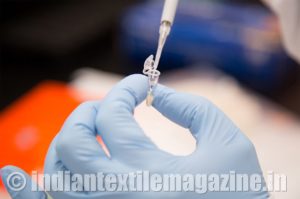Expansion to new textile materials underway
Applied DNA Sciences, a provider of molecular DNA technology, has come out with innovative supply chain solutions for the global textile industry. Buoyed by the enthusiastic reception to its solutions, the New York-based company has lined up a slew of exciting plans for the Indian market.
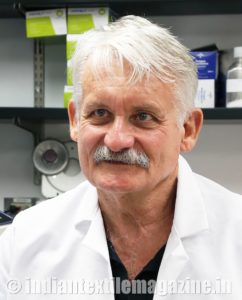
Applied DNA uses biotechnology as a forensic foundation and creates unique security solutions to combat counterfeiting. The company’s unique SigNature molecular tags are at the core of all its security solutions. A result of extensive R&D, SigNature molecular tags are forensic, flexible and durable. Applied at parts per billion, SigNature molecular tags yield stunning accuracy.
In an exclusive interaction with The Textile Magazine, Dr. Mike Hogan, Vice President, Life Sciences, shared many insights into the company’s ongoing programs in different parts of the world, expanding to new textile materials, including cotton, recycled PET, other fibers and textile coatings. ‘CertainT’ is its new supply chain platform that certifies authenticity and origin of products, and is now licensed by Applied DNA to manufacturers in the US, India, China and many other countries.
Dr. Mike Hogan, who has 25 years of experience in translational science, directs technical R&D at Applied DNA, focusing on optimization of the molecular tag structure and stability and the formulation of such molecular tags for delivery to mark textiles, pharmaceutics, cosmetics, plastics, inks and other commercially important media. He also directs development of new methods of DNA recovery and analysis from such materials.
Dr. Hogan is considered a pioneer in the development of lab-on-a-chip during his stint as a professor at Baylor College of Medicine, in collaboration with MIT Lincoln Laboratory and Genometrix, a company that he co-founded to commercialize those technologies.
After completing his B.S. in Biology from Dartmouth College, Dr. Hogan was awarded his Ph.D. with highest distinction by Yale University. He is the holder of 25 US patents, as also many more international patents.
As a researcher and entrepreneur in pharmaceuticals, Dr. Hogan has had extensive interaction with the US Food and Drug Administration (USDA) and other relevant Government agencies. He was Chief Science Officer and Co-founder of Triplex Pharmaceuticals, one of the early biopharma players in the area of DNA therapy.
Also present at the interview was Mr. Rajeev Kewlani, Associate Director, Antar Advisors Pvt. Ltd., which represents Applied DNA in India.
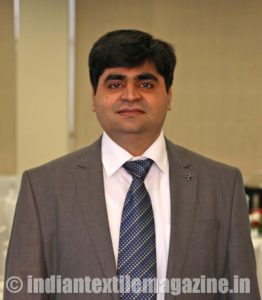
We began by asking Dr. Hogan about his views on whether the DNA market for textiles is still evolving, with respect to textiles. He answered in the affirmative, saying: “Yes. Textiles is such a broad category. We have started out with tagging of cotton, which remains our big business. Now we are moving into synthetics. In the field of textiles, you need to continuously innovate. The market is therefore still evolving with several new interesting possibilities emerging.”
While now the DNA tagging in textiles takes place at the raw material stage, Dr. Hogan stated that he foresees a lot more tagging at later stages being done in the near future as the technology evolves over a period of time.
Responding to a query regarding the key demand drivers for the DNA market, he said: “The drive is coming from the retailers, as well as the manufacturers and spinners within the supply chain. They want to know where the textile comes from, what they are made up of, and also where the cotton is going. The same thing is happening with polyester. People want to know whether a particular brand’s claim of recycled polyester is true or not. Once the yarn is drawn into fiber, it is pretty hard to tell between recycled and non-recycled material unless you tag it.”
Pointing out how the way the company is working is also evolving, Dr. Hogan gave the example of Pima Cotton, which is becoming a brand defined by the authentication of the molecule on the fiber. “The gin is our first point of intervention with the cotton. One of the big changes that has happened in recent times is that our work has become highly automated. The people at our facility monitor the ongoing cotton right before it goes to the baling process and apply DNA. Last year we have made a lot of progress in how we are able to deploy this kind of automated system. Our CertainT compliance team can now monitor work at multiple gins and can now see on a screen how much DNA is being delivered and applied at a particular location in real time.”
Continuing further on the progress that has been made he said: “We have developed a much more portable type of analysis. We had been doing methods of DNA analysis which had to be done in highly regulated conditions and ISO certified labs. However, we soon realized that it is important to do this kind of testing outside our US facility too. We are in fact in the process of setting up a lab in India and are working towards DNA analysis for cotton that can work in a semi-portable way. We want to make it something that can be put in a briefcase and shipped and set up on location. We had set up portable DNA devices at the gin. Sampling was being done right at the gin. The goal is to be able to do this kind of supply chain monitoring at multiple locations.”
Adding to the QA process
As of now, the company has its hands full working with literally every type of cotton that is produced in the US, whether it is Pima Cotton, ELS or the Upland variety. But what about working in other countries? Egyptian cotton, for instance. To this Dr. Hogan replied: “We are always ready. I think the goal is to work with all those who produce cotton, in any part of the world. It is important that we work with third parties and others, as it allows us to be constantly updated on the knowledge about raw cotton that is coming into the gins.”
Asked about the kind of engagement that the company has with clients in India, a market where ELS cotton is used extensively, he explained: “We are part of the manufacturing quality process in a sense. Testing of DNA adds to the strength of a company’s quality control and quality assurance processes. We therefore work closely with our clients and find out how best to integrate the testing information as part of a continuously improving quality management system.”
Giving an example of Himatsingka Seide, a leading name in the Indian textile industry, with whom Applied DNA Sciences has worked in India for the past few years, Dr. Hogan observed that Himatsingka provides quality testing for the DNA at the spinning stage. Elaborating further he said: “Rather than relying only on a paper trail, you can be sure that the cotton being used is in fact 100% authentic US cotton. We test to find out whether it is so or not. Basically, the measurement of DNA that we are doing is not only to enhance the paper trail that is already there, but also ensure that the product itself is authentic. With our Indian lab coming up pretty soon we will have a situation where such clients can send their samples directly for evaluation.”
He added in the same breath that the doors are always open and, apart from Himatsingka, there are several leading players in the Indian market who are keen on utilizing Applied DNA’s molecular technology in pharmaceuticals, agrochemicals and automotive that go beyond textiles.
Market drivers
Highlighting another key market trend that is driving forward the market for molecular tagging, Dr. Hogan said: “The millennial population, which is expected to constitute half the global population by 2020, has huge purchasing power. They are the ones who will be making a majority of the purchase decisions. They are sensitive to issues such as sustainability, traceability, authenticity, etc. This generation has questions in their mind. Where did the raw material for this product come from? Does it contain any conflicting material? The days of relying only on paper documents for traceability are being frequently challenged and making way for scientifically-backed technologies. Millennials want to see whether there is any scientific backing to a particular claim of a manufacturer or brand. In today’s scenario, the brands also don’t want to end up facing a situation tomorrow where they find that there is a conflicting material in their product.”
Agreeing completely with the views, Mr. Kewlani said: “So you see the entire supply chain can be on-boarded. The molecular tagging enables every possible kind of information to be accessible. We have gone one step further and are putting QR codes on the tag so that you can find the entire history of a particular raw material. In fact, by tagging the product itself, you go beyond tracking boxes or container loads (like RFID tags do) to tracking and tracing fibers. That’s the power of molecular tagging”.
Along with home textiles, the duo felt that there are other areas with huge potential emerging in textiles, such as baby apparels, and high performance and functional garments.
Uniqueness of the molecule
Dr. Hogan also pointed out that molecular tagging not only helps in traceability. In certain instances, it also helps companies and brands vis-à-vis the warranties that they give on their product. “This is particularly so in the case of outdoor use textiles. The claim in these cases usually is about their performance and reliability and typically these companies would offer a warranty. This claim also enables them to charge a substantial premium. Now, with molecular tagging brands can confidently promote and sell their products as having genuine claim and are therefore superior to others available in the market. The technology empowers customers who use it for product claims – market differentiation. Knowledge is power. This is a revolution that manufacturers never experienced in supply chains before.”
Observing how it is impossible to copy the tagged DNA molecules, Mr. Kewlani said: “Applied DNA introduces DNA at parts per billion, infinitesimally small amounts are used, that it is impossible to copy. In fact, if you don’t have the technology to amplify it, you won’t even know that the DNA is there in the first place. Moreover, the DNA also does not physically alter the quality or performance of the material in any way.”
Making another important point, Dr. Hogan observed: “Moreover, it is also not a very costly system. It is a case of being able to bring some discipline to your existing system. The molecular tagging process generally does not alter your manufacturing process in any way. Another benefit is the fact that it can be added at any point of manufacturing without having to change the day-to-day operations or process.”
What is ‘CertainT’?
The company has created quite a buzz in the market with ‘CertainT’ in recent times. Explaining what it is all about, Mr. Kewlani said: “CertainT is an integrated supply chain platform for verifying authenticity from the source to retail. It’s about bringing certainty through traceability, transparency and trust in supply chains that are at risk of many uncertainties. Let me tell you how this platform evolved. We had started out with tagging fibers. It then led to following those fibers to yarn and fabric. By listening and learning about the textile process, we were able to accommodate our supply chain partners to begin to change the mindset from relying just on paper documents but to thinking and implementing an authentication system that would offer a more definitive check of the entire supply chain. You cannot expect to do 5 to 10 tests a year and then claim a product to be pure. So, we thought there needs to be a system where the entire supply chain partners are following certain protocols. This is how CertainT came into being, and it’s very exciting to see how the textile industry, especially in India, has taken to using it.”
Adding further information Dr. Hogan quipped: “The CertainT x-factor is providing that trust factor to the end-user. When the end-user sees the CertainT logo, he or she is assured that the source has been authenticated at various stages and proven forensically. Most companies spend millions of dollars on advertising and marketing, but we are seeing a change in how these dollars are now being brought back to ensuring the source raw materials are true. If you have the best source materials, you will end up with the best products. Consumers know that because they will experience it when they purchase the product. It’s that simple.”
The CertainT brand is already being sought after by leading players in the textile field. For example, the company has recently entered into a partnership with GHCL for bedding using recycled PET and regular PET, and Loftex Home based in China, a leading manufacturer of towel using the CertainT platform, to ensure that its towels that have recycled plastic water bottles (PET) as one of the key ingredients to help retailers meet and/or exceed their sustainability goals.
Dr. Hogan added: “For a relatively small technology company, we have quite a big quality group. Our clients are also beginning to understand that our systems are complementary to their efforts and welcoming us with open arms. They understand that the molecular tagging is not changing anything in their manufacturing process, but only adding another layer to their quality control and assurance procedures.”
Global presence
When queried as to whether there are other global retailers who are keen on molecular tagging, Mr. Kewlani replied: “I will give you another example, in leather. We are doing this big project in the UK wherein 7 big brands, competitors in fact, have come together to make their leather supply chain DNA tagged from farm to shelf. It shows that global multinational brands are committed and are willing to invest in technology to keep their supply chains real and safe. Transparency and traceability means trust in the supply chain, which in turn means enhanced consumer confidence.”
Currently, apart from India and the US, the other key global markets for the company include the UK, China, Pakistan, Turkey and the Scandinavian countries.
100% Indian subsidiary
Both Dr. Hogan and Mr. Kewlani were unanimous in their view that India is going to be Applied DNA Sciences’ key market in the near future. Pointing out the focus of the company in this key market, Dr. Hogan stated: “India is the biggest offshore opportunity for us for sure because of the enormous strides taken by the various sectors in the country, whether it is textiles, pharma or automobiles. We foresee a lot of our growth through our Indian operations.”
Just how seriously the company is taking the Indian market can be gauged from the fact that it is in the process of setting up a 100% subsidiary in the country. Going into details, Mr. Kewlani said: “India has traditionally been a slow starter when it comes to accepting new technologies. However, things are now changing. Applied DNA has already started doing a lot of work in India. For example, Applied DNA has entered the synthetics space and signed a multi-year licence agreement with GHCL Ltd., a global manufacturer of home textiles, to provide CertainT services in connection with source-verified, polyethylene terephthalate (PET), and recycled PET (post-consumer) in select home textile products.
Organic cotton, although the farm holdings are very small in size and scattered, is another big opportunity. Similarly, there are several other avenues that are open for exploration in the Indian market, and the Indian subsidiary will have a major role in the near future.
New lab in India
A key part of the Indian subsidiary will be the state-of-the-art laboratory that the company is in the process of establishing in Ahmedabad. Going into details about the lab, Mr. Kewlani observed: “Having a lab here in India not only means that things can move forward quickly but also it will enable our US lab to focus more on R&D. Moreover, we also need to service our pilot projects in India. We have been approached by several companies for such projects. If these pilot projects have to be turned around in time, we need to have our lab here.”
According to Dr. Hogan, the company has finalized details regarding the space, vendors, equipment, etc., and if everything went according to the plan, a soft launch can be expected by the end of 2017.
Future prospects
Speaking about the future growth avenues that are emerging in the field, Dr. Hogan remarked: “There are basically 3 big business opportunities available to us. Cotton is one where we have enormous capacity to scale up and grow. Then there is synthetics, where again we have the capacity to grow almost as fast as that business can accommodate. And then we are involved in a lot of ongoing printing projects as well as pharmaceutical and government programs. We, for example, routinely incorporate DNA into various types of inks (inkjet, pad printing, offset and flexo), and these have been applied onto pharmaceutical tablets, packaging as well as microchips.”

